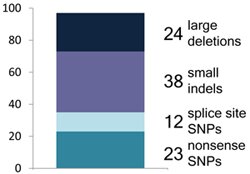The Genomes Unzipped team has been quiet for the last few weeks as we prepare for a major announcement – stay tuned next week to find out more. In the meantime, here are a few things we found around the web this week.
China’s sequencing powerhouse BGI collaborated with Danish researchers to analyse the exomes (the sequences of all protein-coding genes) of 200 individuals from Denmark, in a study published in Nature Genetics. The researchers took an approach similar to that adopted by the 1000 Genomes Project, sequencing each of the individuals at fairly low depth (with each base in the exome being covered on average by 12 sequencing reads, as compared to at least 30 for a “high quality” genome), but then using a statistical approach to identify variants and infer their frequency within the population. The headline finding was that the sequenced individuals carry more rare protein-altering polymorphisms than expected; the authors conclude:
Based on our findings, we support the idea that much of the heritable variation affecting fitness is caused by low-frequency mutations, which are often overlooked in studies based on genotyping rather than resequencing.
The conclusion that much of the “missing heritability” for disease is driven by rare protein-altering mutations is plausible, but this study in and of itself doesn’t provide compelling evidence in support of it. Fortunately, more definitive studies are underway: as tens of thousands of exomes from disease patients and controls accumulate over the next two years, the contribution of rare protein-coding variants to disease (or surprising lack thereof) will soon be fairly definitively established. [DM]
Bio-IT World has an excellent special issue on “The Road to the $1000 Genome”, highlights include an article pondering the often underestimated costs of analysis of genome sequences, and an update on Hugh Reinhoff’s personal quest to find the mutation underlying his daughter’s genetic disease. The issue coincides with the launch of editor Kevin Davies’ new book The $1000 Genome, which was favourably reviewed this week at 23andMe’s blog The Spittoon. [DM]
In Science this week, John Travis takes a look at the technically and ethically challenging world of Native American genetics, focusing on the effort to sequence the nuclear genome of Lakota warrior Sitting Bull from snippets allegedly taken from the man’s hair. The story includes the unusual method by which the main researcher in the project gained approval to study the Native American’s remains:
LaPointe said the basement ceremony was required to get permission from Sitting Bull himself, who was killed in 1890. Willerslev says something odd happened at the ceremony, recalling a blue-green light that ran across his body and into his mouth. LaPointe says the spirit of Sitting Bull tested the geneticist and approved. As a result, LaPointe allowed Willerslev to cut a short section from a long braid of Sitting Bull’s still-shiny black hair and fly it back to the University of Copenhagen for analysis.
If only all ethics committee meetings were livened up by pyrotechnics… [DM]
A piece in Fortune tells the remarkable story of Hugh Martin, CEO of the massively-funded third-generation sequencing startup Pacific Biosciences, who has battled openly with cancer while guiding the company through funding rounds and towards a public share offering. [DM]
 This is a guest post by Peter Cheng and Eliana Hechter from the University of California, Berkeley.
This is a guest post by Peter Cheng and Eliana Hechter from the University of California, Berkeley.
 RSS
RSS Twitter
Twitter
Recent Comments